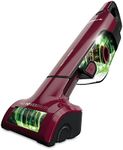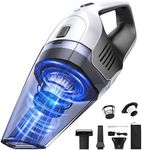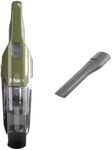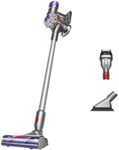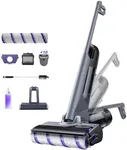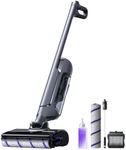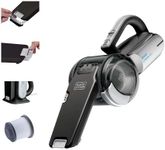Buying Guide for the Best Handheld Vacuums
Choosing a handheld vacuum can make cleaning small messes, cars, upholstery, or tight spaces much easier. The right model for you depends on where and how often you plan to use it. Think about the surfaces you'll clean, how portable you need it to be, and whether you want to tackle pet hair, crumbs, or just light dust. Understanding the main features will help you find a vacuum that fits your lifestyle and cleaning habits.Suction PowerSuction power refers to how strongly the vacuum can pull in dirt and debris. This is important because higher suction means better cleaning, especially for stubborn messes or pet hair. Suction is often measured in air watts or kilopascals, but sometimes just described as 'strong' or 'standard.' Lower suction is fine for light dust and crumbs, while higher suction is better for deep cleaning or picking up larger debris. If you plan to use your handheld vacuum for quick cleanups on hard surfaces, moderate suction is usually enough. For car interiors, pet hair, or upholstery, look for a model with higher suction.
Battery LifeBattery life tells you how long the vacuum can run before needing a recharge. This matters because a longer battery lets you clean more in one go. Battery life can range from about 10 minutes to over 30 minutes. Shorter battery life is fine for quick spot cleaning, while longer battery life is better if you want to clean your car or several rooms at once. Think about how long your typical cleaning session lasts and choose a vacuum that matches your needs.
Weight and SizeWeight and size affect how easy the vacuum is to handle and store. Lighter and more compact models are easier to carry around, especially for cleaning stairs, cars, or high shelves. Heavier models might offer more power or a bigger dustbin, but can be tiring to use for long periods. If you need something for quick, frequent use or have limited storage space, go for a lightweight, compact vacuum. If you don’t mind a bit more weight for extra features, a larger model might suit you.
Dustbin CapacityDustbin capacity is the amount of dirt and debris the vacuum can hold before you need to empty it. A larger dustbin means you can clean more without stopping, but it can also make the vacuum bulkier. Smaller dustbins are fine for quick cleanups but need to be emptied more often. If you plan to use your handheld vacuum for bigger messes or less frequent emptying, look for a larger dustbin. For small, everyday messes, a smaller dustbin is usually enough.
Filtration SystemThe filtration system traps dust and allergens inside the vacuum. This is important if you have allergies or want to keep the air clean. Some vacuums use basic filters, while others have HEPA filters that capture very fine particles. If you or your family have allergies or pets, a vacuum with a better filtration system is a good choice. For general cleaning, a standard filter is usually sufficient.
Attachments and AccessoriesAttachments and accessories, like crevice tools, brush heads, or pet hair tools, help you clean different surfaces and hard-to-reach areas. More attachments make the vacuum more versatile, but also add to the storage needs. If you want to clean cars, upholstery, or pet hair, look for a vacuum with specialized tools. If you just need to clean floors or countertops, fewer attachments may be fine.
Charging TimeCharging time is how long it takes to fully recharge the vacuum’s battery. Shorter charging times mean less waiting between uses, which is helpful if you use the vacuum often. Charging times can range from under an hour to several hours. If you plan to use your vacuum frequently or for longer sessions, a model with a shorter charging time can be more convenient. For occasional use, charging time may not be as important.

